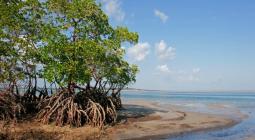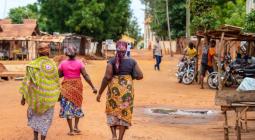Cities and coastal erosion: how resilient are they in West Africa?

The 7,000 km long West African coastline shared by Senegal, Togo, Nigeria and other countries is increasingly threatened by coastal erosion. Benin, for example, loses an average of four meters of shoreline per year along 65% of its coastline. What are the characteristics of this phenomenon and what are the main resilience measures at both national and sub-regional levels? Find out in this article, part of our special feature on Seas and Oceans.
Nearly 3.5 billion people live within 150 kilometres of the shore, which means that 60% of the world’s population lives in the great coastal zone. Yet no continent is immune to coastal erosion. The impact varies from country to country, but the causes are generally the same: the effects of climate change (flooding and tsunamis), increasing urbanisation and the resulting human activity. Environmentalists often question certain human activities that exacerbate coastal erosion, particularly through the weakening of dune belts.
These include the marketing of sea sand by coastal communities, the construction of dams, port developments and underwater oil drilling. In West Africa, where the coast is home to almost a third of the sub-region’s population and generates up to 56% of its gross domestic product (GDP), the degradation of coastal areas costs Benin, Ivory Coast, Senegal and Togo a total of 3.8 billion dollars a year. According to the World Bank, this is equivalent to 5.3% of their GDP.
In the Senegalese council of Bargny, this erosion is most often seen in the devastation of beaches, mangroves and agricultural areas, which are essential to the livelihoods of communities living by the sea. The same scenario applies in Nigeria. In this West African country, where demographic growth (currently 219 million inhabitants, rising to 211 million by 2021) is no longer slowing down, a number of Nigerians have over the years settled in coastal towns including the economic capital Lagos, Port-Harcourt and Ayetoro (Ogun State). As recently as June 2024, Ayetoro was the target of a spectacular rise in water levels that destroyed everything, starting with shops and other fishermen’s facilities.
WACA, ResIP West Africa Coastal Area, the major sub-regional response
Beyond the economic consequences, coastal erosion has already killed nearly 13,000 people in West Africa, according to the World Bank. This situation cannot continue. The time has come to find solutions. At sub-regional level, resilience means pooling the efforts and strategies of six countries. Through the West African Coastal Zone Resilience Investment Project (WACA-ResIP), Benin, Ivory Coast, Mauritania, São Tomé and Príncipe, Senegal and Togo have been pooling their efforts and strategies since 2018 to fix dunes, build protective structures and dykes, and restore wetlands, mangroves, lagoons and drainage systems.
At a total cost of 47.3 million euros (31 billion CFA francs), the initiative is co-financed by the Global Environment Facility (GEF) and the World Bank Group via the International Development Association (IDA). The first benefits are expected on the Beninese coast, where the IDA has granted 36 million dollars for the installation of rigid hydraulic structures on the ocean’s edge or on a river bank to slow down water currents and limit sediment movements. The other part of the funds from this development partner will finance the ‘recharging of 6.4 million m3 of sand in the Agoué district and the construction of cycle paths and car parks’ in the coastal areas of Agoué and Hillacondji.
At the same time, Benin is planting palm trees along its coastline.
But the WACA alone does not seem to be enough for the Beninese government, which has been experimenting with other solutions since 2021, including the planting of 500,000 coconut palms and other types of palms on its coastal strip. These plants are produced locally by the Institut national des recherches agricoles du Bénin (Benin National Institute for Agricultural Research) (INRAB) and should have a dual long-term impact: combating coastal erosion and developing tourism, according to the Beninese Ministry for the Environment and Sustainable Development.
Trees, particularly palms, play an important role in stabilising wetland ecosystems and biodiversity in the coastal strip. ‘Like mangroves, coastal trees provide excellent shelter for fragile ecosystems thanks to their deep roots, and they also help to stabilise the soil. Trees also form natural barriers that slow down wind speeds. By reducing this wind force, the green giants (trees, editor’s note) minimise the impact of storms on the coast and reduce erosion’, says the New Caledonian platform Neocean.
Socio-economic reconstruction of coastal communities: the Togolese example
In Togo, whose coastline is 50 km long, the authorities have a very clear roadmap, steered by the High Council for the Sea, which places particular emphasis on the socio-economic reconstruction of victims of coastal erosion. It is in this context that the project to strengthen the resilience of Togo’s coastal communities to climate change (R4C-Togo) was launched, benefiting 70 women’s cooperatives that depend on marine resources. It is funded to the tune of 8.9 million dollars (over 4.4 billion CFA francs) by the Food and Agriculture Organization of the United Nations (FAO).
Between securing the water supply, collecting fuel for cooking and heating many homes, the stakes are high in the Plateaux region, because in 2022, the overflowing waters of the Mono river (on the border with Benin, editor’s note) will have untied the Ila and Anyékpada bridges. Ultimately, the project will improve food security for 99,500 Togolese thanks to innovative technologies and solutions developed by 2,100 local entrepreneurs. However, given the rise in sea levels, coupled with unpredictable flooding, will all these institutional efforts really be able to halt coastal erosion and its many consequences in West Africa?






